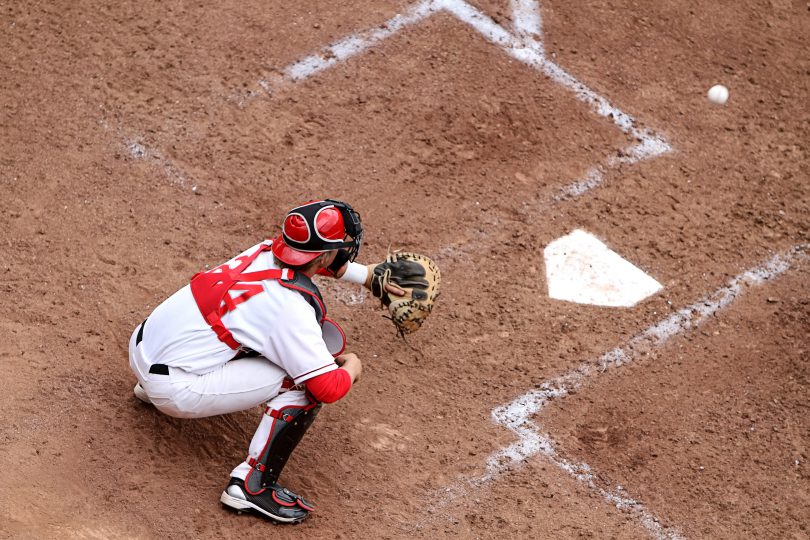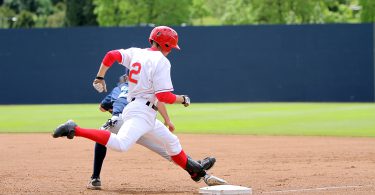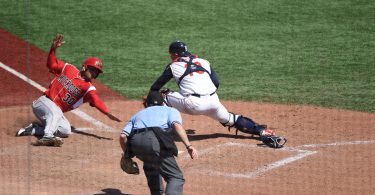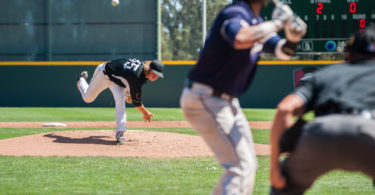The Situation:
There are runners on 1st and 2nd in the bottom of the 3rd inning. The home team is up 2-0 and looking to extend their lead with a two out rally after a single and a walk. The right-handed batter is down in the count 0-1 as he faces off against the right-handed starter. The catcher taps the outside of his leg quickly just before he puts down his sign. The first baseman taps his toes into the ground, and goes into his pre-pitch routine.
The Play:
The pitcher comes set, pauses briefly, and delivers as the runners bounce off the bases into their secondary lead. The pitch is a fastball, just off the outside corner, by design. It’s a modified pitchout called by the catcher. The catcher receives the pitch and quickly snaps a strike down to the first baseman who has slipped in behind the runner.
The Outcome:
The runner realizes he’s in trouble as he scrambles back towards the first base bag. The ball beats him and he tries to swim his right hand backwards to avoid the tag. Despite his last-ditched effort to get in safely, he is tagged out and the inning is over.
What Went Wrong:
This play highlights two important lessons. The first—a well-executed defensive play, and the second—a breakdown of the base running system. We’ll start with the well-executed play by the defense.
This catcher back-pick play, set up from the catcher and relayed to the first baseman and pitcher shows a defense working together. The pitcher enables the catcher to call a modified pitchout because he got ahead in the count the previous pitch, and the catcher shows great awareness by noticing the trail runner being lazy getting back to the bag. The catcher tapping the outside of his leg prior to giving the pitch sign sets the wheels in motion, and the first baseman acknowledges he is on board with the play by tapping his toes into the ground. With everyone knowing their responsibilities, all that is left is execution. The pitcher starts the play off by giving as routine and boring of a delivery as possible (this is an important piece of the puzzle, as giving too much attention could tip the runners off or cause them to shorten their secondary leads). The pitcher then delivers a great throw for the catcher to handle, the catcher receives it well and gets rid of a strike quickly. The first baseman is in position to receive the throw, and easily tags out the runner. It’s important to note that this is a designed play and likely one that has been practiced a lot. With everyone knowing where they should be and what to do, the play becomes much less of a risk than a random back-pick from the catcher.
On the other side of the play is the mistake by the trail runner. He likely wants to get a good jump on a ball in the gap to try to score, but he must realize where he is in relationship to the first base bag and work hard to not only get a good secondary lead, but also to get back to the base. The trail runner doesn’t have a system in place to guard against the back pick, and he pays because of it. A good rule of thumb is to always take two hard steps back to the base after the catcher has secured the ball. If the back pick comes, you are well on your way to getting back to the base with the two hard steps and a dive. If the catcher gets the ball back to the pitcher routinely, you will see there is no threat during those two hard steps and can cruise back to the bag, making sure to know where the ball is at all times. The two hard steps back are a system that guards against the unexpected and remind the player to work hard both ways. You can bet that the next time the trail runner is in the same position, he’ll be thinking the game and making sure not to get caught wandering back to the base and susceptible to the back pick. Once you have executed the system repeatedly, it no longer becomes a conscious thought and is done automatically. You can see the execution of the play right here.







